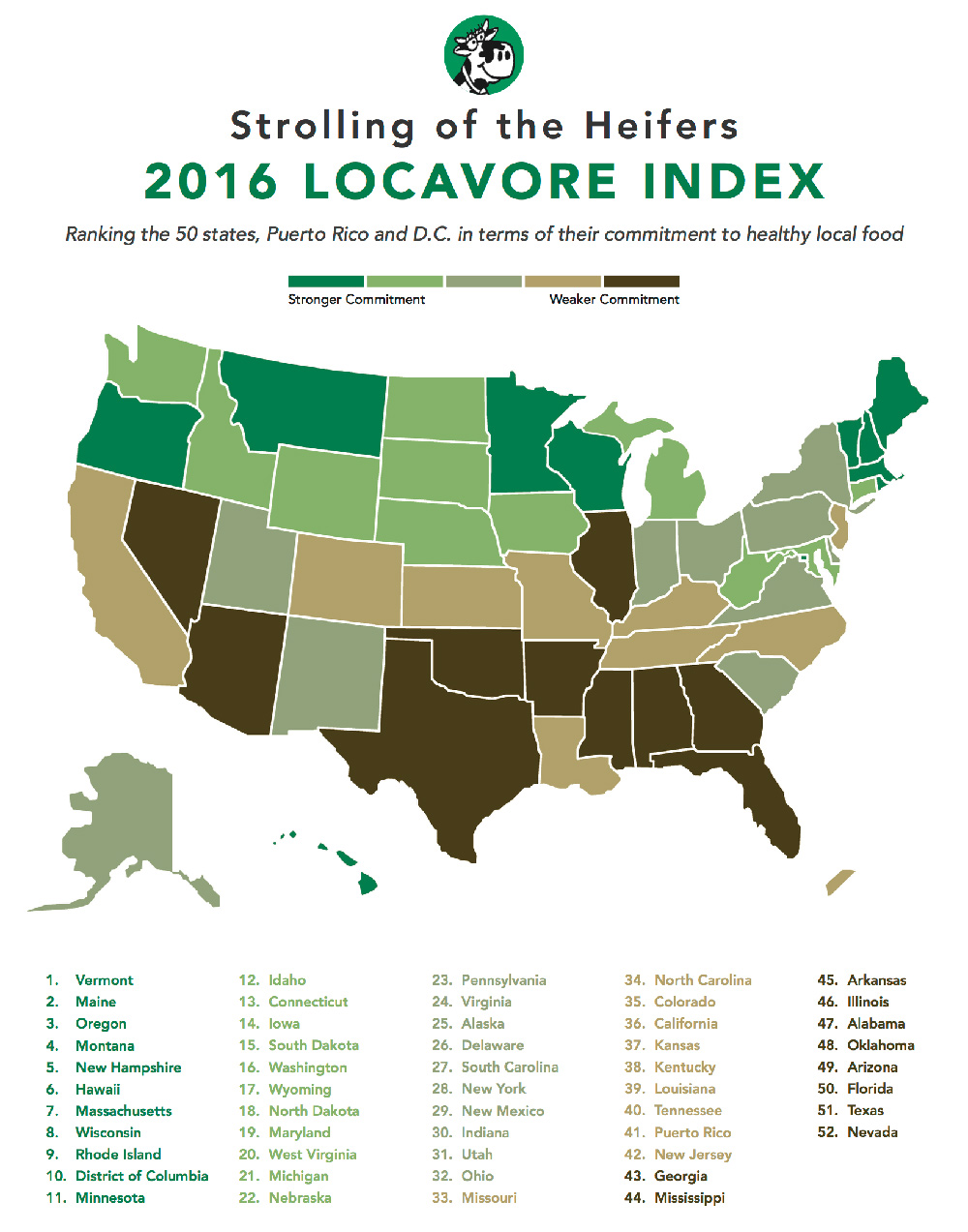The 2016 Strolling of the Heifers Locavore Index
Strolling of the Heifers is a non-profit food advocacy organization based in Vermont. For the last five years, they’ve been putting together an index to rank the 50 states, plus Puerto Rico and the District of Columbia, using a variety of factors related to local food production and consumption.
The goal of the index is to “stimulate efforts across the country to use more local food in homes, restaurants, schools and institutions,” according to Strolling of the Heifers executive director Orly Munzing.
Vermont has been the reigning champion since the index started, and they came in first again this year. Ms. Munzing adds, “The index has stimulated a lot of discussion and a lot of action in many states to improve their ranking. We’re proud that Vermont is still number one, but it is great to see so many other states following Vermont’s lead in building strong local food systems.”
Read more: 4 Uncommon-Sense Guidelines for Food Safety and Nutrition
What Makes a State Locavore Friendly?
Strolling of the Heifers uses five factors to determine how locavore friendly a state is. The first factor is direct-to-the-public food sales revenue from farms in each state. They include revenues from farm stands, farmers markets, CSAs, and online sales, and they use those figures to calculate the per capita spending on local food.
Next they tally up the total numbers of farmers markets, CSAs, and food hubs in each state. Food hubs are tracked and listed by the USDA, and they’re basically defined as any company or organization that facilitates the distribution of locally produced food – coops, health food stores, local non-profits, etc.
This year’s Index incorporates new data from the USDA from its “Know Your Farmer – Know Your Food” grants.
And finally, they take a look at farm-to-school programs, in which schools buy and feature locally produced, farm-fresh foods. They calculate the percentage of school districts which have farm-to-school programs, and the average percentage of district food budgets spent on local food.
Is Your State Locavore Friendly?
After Vermont, the next four spots in the Index are occupied by Maine, Oregon, Montana, and New Hampshire. Montana moved up from seventh place to fourth place this year, based largely on strong investment from the USDA Know-Your-Farmer grant funding.
Rounding out the top 10 are Hawaii, Massachusetts, Wisconsin, Rhode Island, and the District of Columbia.
For those of us in Texas, it’s hard to feel good about our state’s 51st place ranking. Texas has come in at or near the bottom of the list since the Index started five years ago. But the goal of the index isn’t to point fingers or assign blame – it’s all about sparking change from the bottom up to inform and educate people about their food.
According to Chuck Ross, Secretary of the Vermont Agency of Agriculture, Food and Markets, “As we all know, farmers are very effective educators, and often best positioned to promote agricultural literacy in our communities. The future of a successful agricultural economy in which farmers and producers can prosper and consumers have access to safe, affordable, healthy food depends on an agriculturally literate and engaged people.”
Read more: How Eating with the Seasons Changed My Life
2016 Locavore Index Rankings
Here are the full rankings of all states for the 2016 Strolling of the Heifers Locavore Index (2015 rank is in parentheses).
#1 – Vermont (1)
#2 – Maine (2)
#3 – Oregon (4)
#4 – Montana (7)
#5 – New Hampshire (3)
#6 – Hawaii (8)
#7 – Massachusetts (5)
#8 – Wisconsin (6)
#9 – Rhode Island (9)
#10 – District of Columbia (18)
#11 – Minnesota (11)
#12 – Idaho (16)
#13 – Connecticut (10)
#14 – Iowa (13)
#15 – South Dakota (24)
#16 – Washington (12)
#17 – Wyoming (22)
#18 – North Dakota (31)
#19 – Maryland (21)
#20 – West Virginia (14)
#21 – Michigan (15)
#22 – Nebraska (27)
#23 – Pennsylvania (17)
#24 – Virginia (19)
#25 – Alaska (33)
#26 – Delaware (25)
#27 – South Carolina (23)
#28 – New York (20)
#29 – New Mexico (32)
#30 – Indiana (35)
#31 – Utah (30)
#32 – Ohio (34)
#33 – Missouri (37)
#34 – North Carolina (28)
#35 – Colorado (26)
#36 – California (36)
#37 – Kansas (38)
#38 – Kentucky (29)
#39 – Louisiana (47)
#40 – Tennessee (40)
#41 – Puerto Rico (not ranked)
#42 – New Jersey (39)
#43 – Georgia (44)
#44 – Mississippi (46)
#45 – Arkansas (42)
#46 – Illinois (41)
#47 – Alabama (43)
#48 – Oklahoma (45)
#49 – Arizona (50)
#50 – Florida (48)
#51 – Texas (51)
#52 – Nevada (49)
You can view the detailed results including all of the ranking factors in this PDF: 2016 Locavore Index Graphic Table
You can find the full rankings for previous years using the links below:
2015 Locavore Index
2014 Locavore Index
2013 Locavore Index
2012 Locavore Index
Thanks to Strolling of the Heifers for all the work that goes in to creating this index. Keep on fightin’ the good fight!
Strolling of the Heifers is a Vermont-based food advocacy organization that works to strengthen local food systems by connecting people with healthy local food and encouraging innovation and entrepreneurship in the farm and food sectors. Their programs include the Strolling of the Heifers Parade and Expo, the Slow Living Summit, the Farm-to-Table Culinary Apprenticeship Program, and Windham Grows. You can learn more on the web at www.StrollingoftheHeifers.com and www.SlowLivingSummit.org.










COMMENTS(5)
It is not that Texas is not producing…they just don’t tend to let everyone know about it. Marjory herself has been hesitant to let people know just where she lives and being involved with selling at local markets. We in Texas, tend to be self sufficient, grow it ourselves and if a neighbor needs something, we give it. I don’t mind a bit being # 51.
the biggest problem I can see is this.These farmers use a lot of chemicals in their food and it’s 2-3 times more expensive than the stores.So,it doesn’t do me any good to buy local.I’ll stick to growing my food completely chemical free.
This is probably based on growing food for sales, not each household for their own consumption. I am surrounded by Amish and while they aren’t like they used to be -all farmers- they do grow much of their food for their own families and so does everyone I know in the farm country, or they buy from local stores (not chains) and indivicual farmers that sell at thier home fronts . I don’t know how this index can show all that.
It’s nice to be first in something. If anyone happens to be in the area, the annual parade and expo are coming up on June 3-4-5.